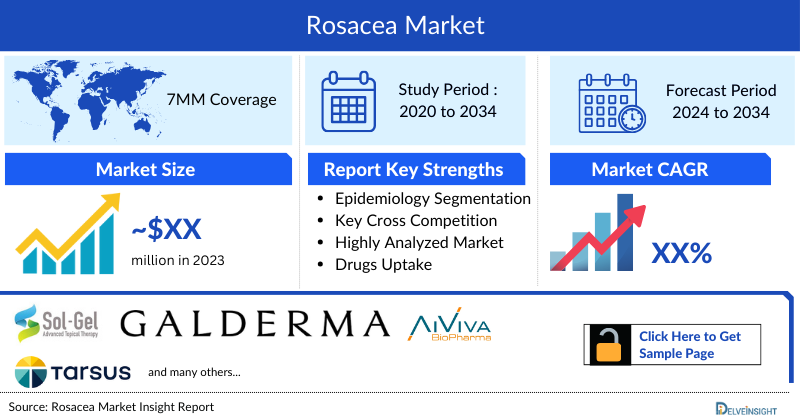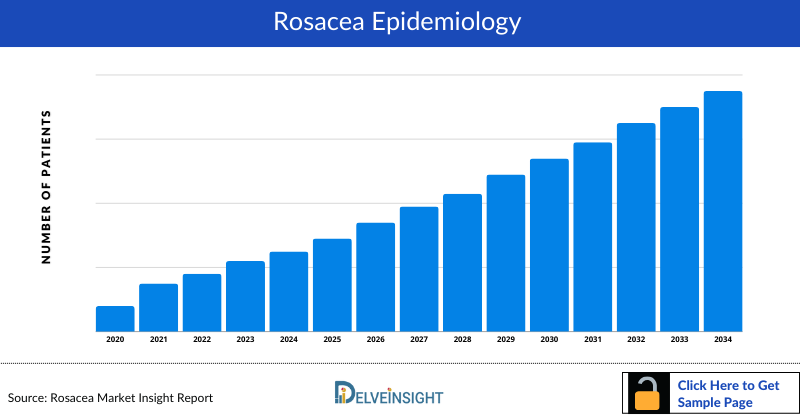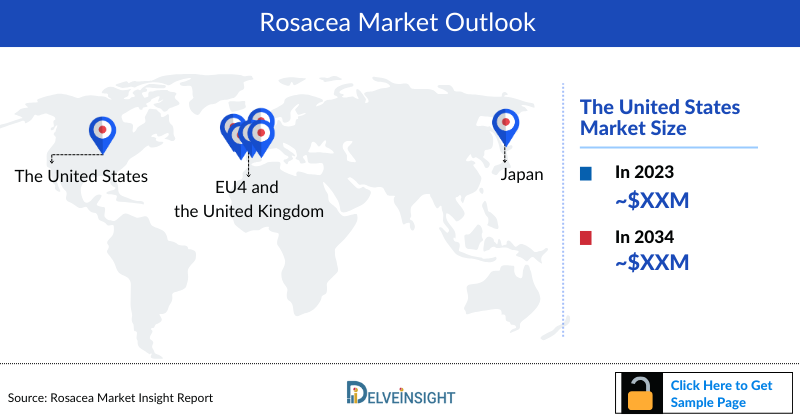Rosacea Market Summary
- The Rosacea Market is expected to experience significant growth during the forecast period (2024–2034). This growth is a direct consequence of various market-driving factors such as improving access to diagnosis and treatment, increased awareness and research, advancements in treatment options, and increasing Prevalence of Rosacea.
- The Rosacea Companies, such as Sol-Gel Technologies, Galderma, AiViva BioPharma, Tarsus Pharmaceuticals, Aobiome Therapeutics, and others
Rosacea Market Insights & Epidemiology Forecast
- Currently, there is only one US FDA-approved product for rosacea which is EPSOLAY by Sol-Gel Technologies and Galderma. This drug is thriving in the rosacea treatment market and is expected to undergo substantial expansion in the foreseeable future.
- While there are several topical treatments available for rosacea, there is a need for more effective treatments that can provide better control of symptoms, particularly for those with moderate to severe rosacea, and for persistent facial redness. Identifying optimal combination therapies could further improve outcomes for patients with more severe or refractory rosacea. Research is needed to determine the most effective approaches for preventing relapse and maintaining remission. With a robust emerging pipeline, the market will be driven by both approved and emerging therapies during the forecast period.
- To propel the market in the coming years, several companies like Tarsus Pharmaceuticals, AiViva Biopharma, and AOBiome developing their assets like TP-04, AIV001, and B244 for rosacea. Due to the anticipated approval of some emerging therapies that are under development in the coming years, the overall rosacea therapeutics market is expected to grow at a significant CAGR over the forecast period.
Request for unlocking the CAGR of the "Rosacea Treatment Market"
Key Factors Driving the Rosacea Market Growth
-
Increasing Prevalence & Awareness
Rising cases of rosacea, especially among fair-skinned populations, along with improved diagnosis rates, are boosting market demand.
-
Advancements in Therapeutics
Introduction of novel prescription topicals, combination therapies, and targeted drug formulations is helping expand treatment options.
-
Expanding R&D Pipeline
Multiple emerging therapies undergoing clinical evaluation offer promise across inflammatory control, vascular modulation, and long-term management.
-
Growth in Dermatology Consultations
Increasing patient preference for dermatologist-guided treatment drives prescription sales for improved therapeutic outcomes.
-
Improved Diagnosis Tools & Guidelines
Better diagnostic frameworks and updated treatment guidelines ensure more patients receive appropriate care.
-
Rising Aesthetic & Cosmetic Concerns
Growing awareness about chronic redness and facial flushing is encouraging treatment uptake, especially among urban and cosmetically active patient populations.
-
Technological Advancements in Devices
Increasing adoption of laser and light-based therapies (IPL, pulsed-dye laser) contributes to market expanding revenues.
DelveInsight’s comprehensive report titled “Rosacea Market Insights, Epidemiology, and Market Forecast – 2034” offers a detailed analysis of rosacea. The report presents historical and projected epidemiological data covering total prevalent cases of rosacea, diagnosed prevalent cases of rosacea, type-specific diagnosed prevalent cases of rosacea, and treated cases of rosacea in addition to epidemiology, the market report encompasses various aspects related to the patient population. These aspects include the diagnosis process, prescription patterns, physician perspectives, market accessibility, treatment options, and prospective developments in the market across seven major markets: the United States, EU4 (Germany, France, Italy, and Spain), the United Kingdom, and Japan, spanning from 2020 to 2034.
The Rosacea Treatment Market Report analyzes the existing treatment practices and unmet medical requirements for rosacea. It evaluates the market potential and identifies potential business prospects for enhancing therapies or interventions. This valuable information enables stakeholders to make well-informed decisions regarding product development and strategic planning for the market.
Scope of the Rosacea Market | |
|
Study Period |
2020 to 2034 |
|
Forecast Period |
2024-2034 |
|
Geographies Covered |
The US, EU4 (Germany, France, Italy, and Spain) and UK, Japan |
|
Rosacea Market |
|
|
Rosacea Market Size | |
|
Rosacea Companies |
Sol-Gel Technologies, Galderma, AiViva BioPharma, Tarsus Pharmaceuticals, Aobiome Therapeutics, and others. |
|
Rosacea Epidemiology Segmentation |
|
Rosacea Treatment Market: Understanding
Rosacea Overview
Rosacea is a characteristic condition that affects the skin by causing facial erythema or redness. Around one in 10 people in the world are affected by rosacea. There are four types of rosacea, though many people experience symptoms of more than one type. Erythematotelangiectatic rosacea, papulopustular rosacea, phymatous rosacea, and ocular rosacea are the four types of rosacea. Papulopustular rosacea (PPR), also referred to as inflammatory rosacea, and type-2 rosacea, is a type of skin condition that may sometimes be mistaken for acne.
Papulopustular rosacea is associated with “whitehead” pustules, which are pus-filled blemishes, and red, swollen bumps. These typically appear on the cheeks, chin, and forehead and are frequently misidentified as acne. These signs and symptoms may flare up for a period of weeks to months and then diminish for a while. The disease sometimes can be mistaken for acne (an allergic reaction or other skin problems). Researchers found that the disease runs in families and may be caused due to the immune reaction against Bacillus oleronius, H. Pylori infection, cathelicidin protein, or due to mite that lives on the skin.
Rosacea Diagnosis and Treatment Algorithm
The disease diagnosis is based on a compatible history and physical examination. The patient may be misdiagnosed with skin conditions that share similar features as adult acne vulgaris, photodermatitis, seborrheic dermatitis, or contact dermatitis. The current therapeutic landscape of rosacea can be divided into four major categories based on the route of administration and the approved usage for the condition. These are topical retinoids, topical antibiotics, oral tetracycline-class antibiotics (TCAs), and oral retinoids. For moderate papulopustular rosacea, combination therapy with oral tetracyclines and topical agents is the first-line choice. Treatment with a topical agent, such as metronidazole, may help maintain remission. Among topical therapies, topical retinoids mainly include tretinoin, tazarotene, adapalene, and clindamycin/tretinoin, and several others are used to reduce erythema, papules and pustules, and telangiectasia.
Among these, tretinoin has the lowest cost and most commonly prescribed topical retinoid, accounting for the majority of the population. Topical antibiotics, such as metronidazole, clindamycin, erythromycin, azelaic acid, benzoyl peroxide, benzoyl peroxide/clindamycin, benzoyl peroxide/erythromycin, sulfacetamide, and sulfacetamide/sulfur, are applied directly to the skin to kill bacteria on the surface of the skin. Currently, EPSOLAY is the only US FDA-approved treatment for rosacea.
Rosacea Epidemiology
The epidemiology section on the rosacea market report offers information on the patient populations, including historical and projected trends for each of the seven major markets. Examining key opinion leader views from physicians or clinical experts can assist in identifying the reasons behind historical and projected trends. The diagnosed Rosacea Patient Pool, their trends, and the underlying assumptions are all included in this section of the report.
This section also presents the data with relevant tables and graphs, offering a clear and concise view of the prevalence of rosacea. Additionally, the report discloses the assumptions made during the analysis, ensuring data interpretation and presentation transparency. This epidemiological data is valuable for understanding the disease burden and its impact on the patient population across various regions.
Key findings from the Rosacea Epidemiological Analysis
- According to various available literature, the Prevalence of Rosacea seems to be on the rise in the US, and in the UK, with a prevalence of about 2 per thousand persons. According to the American Academy of Dermatology, rosacea is a common skin disease that affects around 16 million Americans.
- As per analysis, rosacea prevalence was about 12% in Germany, with erythematotelangiectatic and papulopustular subtypes making up 9 and 3 percent, respectively, while around 18% of the diagnosed were aged 18–30 years.
- As per analysis, rosacea was found in almost 90% of females and 15 % of males. Erythematotelangiectatic (ETR), papulopustular (PPR), phytates (PHY), and ocular subtypes were found in almost 60%, 30%, 20%, and 40% of patients.
- Analysis suggests that there is a paucity of epidemiological data on rosacea, with reported prevalence rates ranging from about 0.10% to as much as 22.00%, in the UK, though there is a paucity of epidemiological data on rosacea.
Rosacea Market Recent Breakthroughs
Rosacea Market Outlook
Topical antibiotics are the most commonly prescribed class of drugs for all sexes and age groups. The most common topical antibiotics prescribed are metronidazole (for an estimated half of the population of topical antibiotics) followed by clindamycin, erythromycin, and azelaic acid. Oral TCAs include the use of tetracycline, minocycline, and doxycycline (Oracea) and act as anti-inflammatory agents without creating bacterial resistance. Of these, tetracycline occupies the major share of prescriptions, followed by minocycline and doxycycline. A significantly lower percentage of prescriptions are brand names for tetracycline and minocycline, whereas prescriptions for doxycycline are generally branded.
ORACEA was also approved by the US FDA for the treatment of inflammatory lesions (papules and pustules of rosacea, however, it has generics in the market. Oral retinoids are also administered and involve the administration of isotretinoin, which is used as an off-label therapy to treat rosacea. It is unknown whether isotretinoin can lead to permanent remission of rosacea. In patients with subtype 2 rosacea i.e. papulopustular rosacea, the size and number of sebaceous glands have decreased with oral isotretinoin. A study found low-dose isotretinoin to be more effective than doxycycline in physician- and patient-assessed outcomes.
The approved as well as off-label products that are being used for the treatment of papulopustular rosacea, and contributing towards the market revenue, belong to either of these above-mentioned therapeutic categories. The effectiveness of approved therapies depends on the severity of the disease. Many companies are developing drugs for the treatment of Rosacea to fulfill the unmet needs. With ongoing research and continued dedication, the future holds hope for even more effective treatments and, ultimately, a cure for this challenging condition. According to DelveInsight, the Rosacea market in the 7MM is expected to change significantly during the study period 2020–2034.
Rosacea Drug Analysis
Marketed Rosacea Drugs
-
EPSOLAY (benzoyl peroxide): Sol-Gel Technologies/Galderma
EPSOLAY (benzoyl peroxide) is a topical cream containing benzoyl peroxide, 5%, for the treatment of inflammatory lesions of rosacea in adults. EPSOLAY utilizes a proprietary technology to encapsulate benzoyl peroxide within silica-based microcapsules to create a barrier between the medication and the skin. The silica-based shell is designed to slowly release benzoyl peroxide over time to provide a favorable efficacy and safety profile. EPSOLAY is covered by granted patents until 2040.
Emerging Rosacea Drugs
The pipeline of Rosacea is quite robust with several products available in the developmental stage. There are several key players involved in the development of promising products such as Tarsus Pharmaceuticals, AiViva Biopharma, Aobiome Therapeutics, and others.
-
AIV001 (axitinib): AiViva BioPharma
AIV001 is a novel formulation of a multi-kinase inhibitor combined with AiViva's proprietary delivery technology, designed for prolonged drug release via intradermal treatment. AIV001 targets multiple pathways to reduce fibroplasia in overlapping phases of wound healing and scarring; targets VEGFR to limit the inflammation and fibrosis associated with rosacea; and inhibits or reduces neovascularization and cell proliferation associated with certain cancers. In nonclinical in vivo studies, AIV001 demonstrated reduced dermal neovascularization and fibroplasia in wound healing models and long residence time in the skin with a single treatment. AiViva has completed a Phase I/IIa clinical trial of AIV001 for incisional scarring and wound healing
-
TP-04: Tarsus Pharmaceuticals
TP-04 is designed to potentially treat papulopustular rosacea and eradicate Demodex mites, which have been reported as highly prevalent in the skin of patients with rosacea, including those with PPR, and may play a key role in triggering inflammatory responses associated with the disease. It is a topical gel formulation of lotilaner, a well-characterized antiparasitic agent that paralyzes and kills Demodex mites by selectively inhibiting parasite-specific gamma-aminobutyric acid–chloride channels. Recently the company announced positive topline results from the Phase IIa Galatea trial evaluating TP-04 for the treatment of Papulopustular Rosacea, which demonstrated statistically significant improvements (p<0.05) in inflammatory lesions And Investigator’s Global Assessment (IGA) score compared to vehicle at Week 12. The company is now determining the US regulatory path ahead.
-
B244: Aobiome Therapeutics
B244 is a topical spray consisting of a single bacterial strain of Nitrosomonas eutropha (N. eutropha) D23. This bacterium can convert ammonia and urea from sweat into nitrite, which possesses antibacterial properties, and into nitric oxide, a signaling molecule that regulates inflammation and vasodilation. B244 is developed to repopulate the skin microbiome with these beneficial bacteria that are typically stripped away by most soaps. The topical application of B244 aims to address symptoms like erythema and telangiectasia in rosacea by leveraging the antibacterial and anti-inflammatory properties of the converted nitrite and nitric oxide. The drug has completed Phase IIa trials. Recently Aobiome and Maruho have entered into an exclusive license agreement, wherein Aobiome grants Maruho an exclusive license to develop, manufacture, and commercialize B244 in Japan, and Maruho will pay Aobiome an upfront payment.
Rosacea Market Segmentation
DelveInsight’s ‘Rosacea - Market Insights, Epidemiology, and Market Forecast – 2034’ report provides a detailed outlook of the current and future rosacea market, segmented within countries, by therapies, and by classes. Further, the market of each region is then segmented by each therapy to provide a detailed view of the current and future market share of all therapies.
Rosacea Market Size by Countries
The rosacea market size is assessed separately for various countries, including the United States, EU4 (Germany, France, Italy, and Spain), the UK, and Japan. In 2022, the United States held a significant share of the overall 7MM (Seven Major Markets) rosacea market size, primarily attributed to the country's higher prevalence of the condition and the elevated cost of the available treatments. This dominance is projected to persist, especially with the potential early introduction of new products.
Rosacea Market Size by Therapies
Rosacea Market Size by Therapies is categorized into current and emerging markets for the study period 2020–2034. One of the emerging drugs anticipated to launch during the forecast period is the TP-04 by Tarsus Pharmaceuticals.
Rosacea Drugs Uptake
This section focuses on the sales uptake of potential rosacea drugs that have recently been launched or are anticipated to be launched in the rosacea market between 2024 and 2034. It estimates the market penetration of Rosacea drugs for a given country, examining their impact within and across classes and segments. It also touches upon the financial and regulatory decisions contributing to the probability of success (PoS) of the drugs in the rosacea market. The emerging rosacea therapies are analyzed based on various attributes such as safety and efficacy in randomized clinical trials, order of entry and other market dynamics, and the unmet need they fulfill in the rosacea market.
Rosacea Market Access and Reimbursement
DelveInsight’s ‘Rosacea Market Insights, Epidemiology, and Market Forecast – 2034’ report provides a descriptive overview of the market access and reimbursement scenario of rosacea. This section includes a detailed analysis of the country-wise healthcare system for each therapy, enlightening the market access, reimbursement policies, and health technology assessments.
Latest KOL Views on Rosacea
To keep up with current Rosacea market trends and fill gaps in secondary findings, we interview KOLs and SMEs working in the Rosacea domain. Their opinion helps understand and validate current and emerging therapies and treatment patterns or Rosacea market trends. This will support the clients in potential upcoming novel treatments by identifying the overall scenario of the market and the Rosacea unmet needs.
Rosacea: KOL Insights
DelveInsight’s analysts connected with 50+ KOLs to gather insights; however, interviews were conducted with 15+ KOLs in the 7MM. These KOLs were from organizations, institutes, and hospitals, such as Stanford Medicine, Johns Hopkins University School of Medicine, and Lifespan/Brown University among others. “Even though management of patients happens by some approved therapies, novel drug development is an ongoing opportunity for patients of this disease group”. “Antibiotic therapy has provided relief to the management of patients, but many prescribers and patients are awaiting the approval of upcoming therapies”.
Rosacea Competitive Intelligence Analysis
We conduct a Competitive and Market Intelligence analysis of the rosacea Market, utilizing various Competitive Intelligence tools such as SWOT analysis and Market entry strategies. The inclusion of these analyses is contingent upon data availability, ensuring a comprehensive and well-informed assessment of the market landscape and competitive dynamics.
Rosacea Pipeline Development Activities
The report offers an analysis of Rosacea clinical trials within Phase II and III stages and examines companies involved in developing targeted therapeutics for rosacea. It provides valuable insights into the advancements and progress of potential treatments in clinical development for this condition. The report covers information on collaborations, acquisitions and mergers, licensing, patent details, and other information for emerging Rosacea therapies.
Rosacea Market Report Insights
- Patient-based Rosacea Market Forecasting
- Rosacea Therapeutic Approaches
- Rosacea Pipeline Analysis
- Rosacea Market Size and Trends
- Rosacea Drugs Market Opportunities
- Impact of Upcoming Therapies
Rosacea Market Report Key Strengths
- 11 Years Rosacea Market Forecast
- The 7MM Coverage
- Rosacea Epidemiology Segmentation
- Key Cross Competition
- Highly Analyzed Rosacea Drugs Market
- Rosacea Drugs Uptake
Rosacea Market Report Assessment
- Current Rosacea Treatment Practices
- Rosacea Unmet Needs
- Rosacea Pipeline Product Profiles
- Rosacea Drugs Market Attractiveness
- Rosacea Market Drivers
- Rosacea Market Barriers
Key Questions Answered In The Rosacea Market Report:
- How common is rosacea?
- What are the key findings of rosacea epidemiology across the 7MM, and which country will have the highest number of patients during the study period (2020–2034)?
- What are the currently available treatments for rosacea?
- What are the disease risks, burdens, and unmet needs of rosacea?
- At what CAGR is the rosacea market and its epidemiology is expected to grow in the 7MM during the forecast period (2024–2034)?
- How would the unmet needs impact the Rosacea market dynamics and subsequently influence the analysis of the related trends?
- What would be the forecasted patient pool of Rosacea in the 7MM covering the United States, EU4 (Germany, France, Italy, and Spain), the UK, and Japan?
- Among EU4 and the UK, which country will have the highest number of patients during the forecast period (2024–2034)?
- How many companies are currently developing therapies for the treatment of rosacea?
Stay updated with us for Recent Articles @ New DelveInsight Blogs




